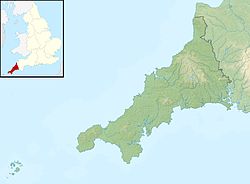| RNAS Culdrose | |||||||||||
|---|---|---|---|---|---|---|---|---|---|---|---|
| Near Helston, Cornwall in England | |||||||||||
 An AgustaWestland Merlin HM2 at RNAS Culdrose | |||||||||||
 | |||||||||||
| Site information | |||||||||||
| Type | Royal Naval Air Station | ||||||||||
| Owner | Ministry of Defence | ||||||||||
| Operator | Royal Navy | ||||||||||
| Controlled by | Fleet Air Arm | ||||||||||
| Condition | Operational | ||||||||||
| Website | Official website | ||||||||||
| Location | |||||||||||
| Coordinates | 50°05′10″N05°15′21″W / 50.08611°N 5.25583°W | ||||||||||
| Area | 623 hectares (1,540 acres) | ||||||||||
| Site history | |||||||||||
| Built | 1947 | ||||||||||
| Built by | John Laing & Son | ||||||||||
| In use | 1947 – present | ||||||||||
| Garrison information | |||||||||||
| Current commander | Captain James Hall | ||||||||||
| Occupants | Flying units: See Units section for full list. | ||||||||||
| Airfield information | |||||||||||
| Identifiers | ICAO: EGDR, WMO: 038090 | ||||||||||
| Elevation | 81.6 metres (268 ft) AMSL | ||||||||||
| |||||||||||
| Source: UK Military Aeronautical Information Publication [1] | |||||||||||

Royal Naval Air Station Culdrose (RNAS Culdrose, also known as HMS Seahawk; ICAO: EGDR) is a Royal Navy airbase located beside the town of Helston, situated on the Lizard Peninsula in southern Cornwall, England, United Kingdom.
Contents
- History
- 1940–1999
- 2000 onwards
- Units
- Royal Navy
- Operations
- Helicopter operations
- Observer training
- Uncrewed aerial vehicle operations
- Other units
- Former Squadrons based at RNAS Culdrose
- Airborne threat simulation
- See also
- References
- Citations
- Sources
- External links
The airbase is one of the largest helicopter bases in Europe. [2] This location serves as the primary operational center for the Merlin Helicopter Force, which constitutes the Royal Navy's fleet dedicated to anti-submarine warfare and is composed of two Fleet Air Arm front line AgustaWestland Merlin HMA2 helicopter squadrons: 814 Naval Air Squadron and 820 Naval Air Squadron. The former is typically associated with a Royal Navy frigate specialised in anti-submarine warfare, while the latter refers to the airborne unit tasked with safeguarding the carrier strike groups of HMS Queen Elizabeth and HMS Prince of Wales. Additionally, the airbase hosts 700X Naval Air Squadron, recognised as the Royal Navy's specialist unit for drone operations.
The airbase also serves as an important training centre for the Fleet Air Arm. New Merlin HMA2 aircrew and engineers receive training at 824 Naval Air Squadron before they move on to one of the frontline squadrons of the Merlin Helicopter Force. It also serves as the base for 750 Naval Air Squadron, which is responsible for training Royal Navy Observers and Royal Air Force Weapon Systems Officers (WSOs). There is also a number of non-flying units at RNAS Culdrose including 1700 Naval Air Squadron which delivers engineering, aviation, and logistical assistance for operations and exercises globally, both at sea and on land. The airbase is equipped with a substantial Air Engineering Training School, which includes a dedicated Survival Equipment Section. Additionally, it houses the Royal Naval School of Flight Deck Operations, the institution responsible for training all personnel involved in aircraft handling.





